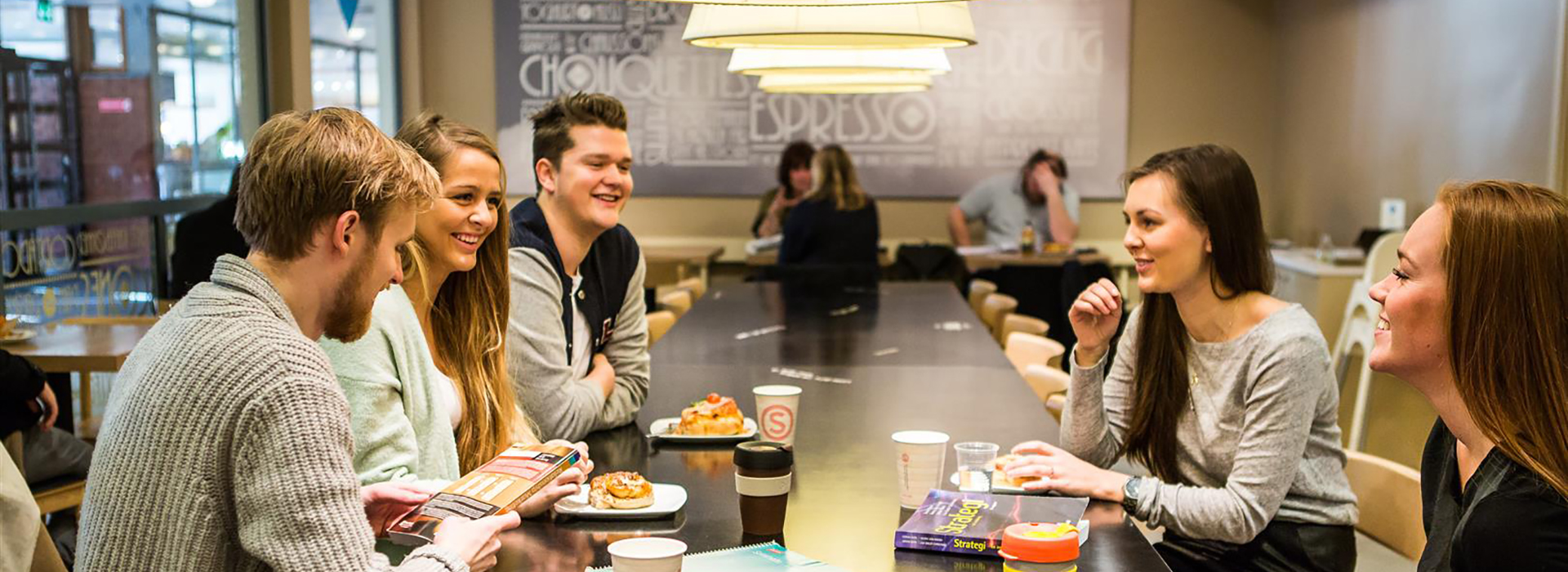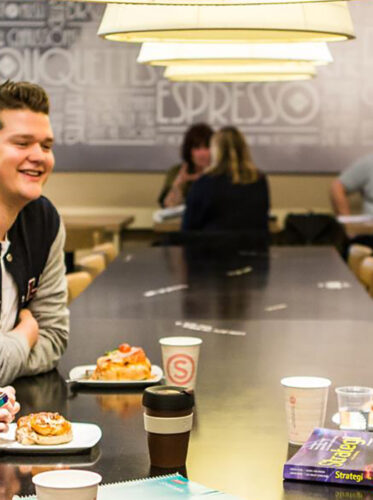Purpose and organization
What is the purpose of the new student house in St. Olavsgate 23?
The Welfare Council wants the new student house to be a central meeting place for all students, across educational institutions, place of residence, interests and needs. The ambition is to strengthen Oslo as an attractive student capital and centre for knowledge, engagement and value creation. The project will help students make a greater mark on the city.
Who wants to use the student house?
It is an important premise that the house should be open and accessible to all the city's students, regardless of finances. This will be a meeting place for volunteering and activity for all students in Oslo, across campuses.
Who is behind the project?
The Welfare Council in Oslo and Akershus has been working since autumn 2017 on a new meeting place for students in Oslo, in close collaboration with SiO. The project was commissioned by the students and is now led together with SiO. The main goals of the project coincide with important goals in Oslo Municipality's Campus Strategy and in the current City Council Declaration.
How is the project organised? How is the project anchored?
The Welfare Council is the project owner for the current project and has, together with SiO, adopted the governance structure for the project. The head of The Welfare Council will lead a steering group consisting of voluntary student representatives, representatives from SiO and representatives from other relevant actors, including Oslo Municipality and the Norwegian Student Society (DNS).
The work to develop the property into a student house is organised as a project with three sub-projects: Content, Building and Agreements/Financing.The entire project with goals, framework and organisation is planned in cooperation between The Welfare Council and SiO.
The project's main goals are included as goals both in Oslo Municipality's Campus Strategy and in the current city council declaration. In addition, the project has support from Oslo's four largest educational institutions, and is in dialogue with the other smaller institutions. The project is also in dialogue with Det Norske Studentersamfund (DNS), which is based at Chateau Neuf, to ensure a complementary and good offer for Oslo's students.
In parallel with this, a process has been initiated to get a voluntary operating organization in place, until the house is finished. This operating organization must consist of already existing student networks, and the operation must be based on student involvement.
Who is on the project steering group?
The steering group is led by Marius Torsvoll from The Welfare Council. The other representatives are:
Chairman of SiO, Stine Johannesen
Executive Director SiO, Andreas Berggren Eskelund
Representative from the educational institutions
Christina Eide (UiO) - student representative
Chairman of DNS Olav Rørstad - student representative
Celine Lyngås Sataøen (ONH)
One observer from the municipality
Are the educational institutions involved?
The educational institutions are involved in the project's organisation, and through their own collaboration meetings regarding the offer, target group and contribution to running the house.
When will the student house be finished?
Once financing of the construction costs has been secured and construction work is under way, the building will be ready within 18 months
About the building itself
What can you say about the property itself?
The iconic property St. Olavsgate 23 is located in the middle of the Tullinkvartalet in the city centre, and is 4,300 square meters spread over five floors, a basement and an attic. The building is stripped inside, and extensive work must be done to get it in a satisfactory condition. The property was designed by Henrik Thrap Meyer and was completed around the turn of the century 1900. Over the years, the building has been used for a church, business premises and cultural and restaurant activities. There have been very different uses and many varied tenants. The building has a history from which the project wishes to reuse elements.
Which elements do you want to continue?
The building where the student house will be established is an old building with a long history. The student body has set demands that safeguarding aesthetics that preserve the building's history must become an important part of the renovation work.
About the construction process
Is the building listed and what does that mean for the student house?
Yes, parts of the building are listed. This will ensure that historical elements will be retained and the expression of the building preserved. At the same time, conservation decisions are not so extensive that they stand in the way of creating flexible and dynamic areas.
What constitution is built in now?
The condition of the building means that we have to carry out extensive renovation work before opening.
What must be done?
The building will be completely rehabilitated, aimed at student activities. This will include work on roofs, windows, facades, technical facilities and extensive interior refurbishment.
Is it necessary to apply for re-regulation?
The project is working with public authorities to clarify the scope of the building application and required permits.
Have you hired an architect?
Yes. The project has engaged DARK architects, as project architect and responsible applicant in the project.
When does the actual construction work start?
We aim to start construction in summer/autumn 2022
What are the biggest challenges with the rehabilitation?
There are complicated works on large building elements, such as roofs, facades, basements, technical facilities and more. It is an extensive job to stitch this together into a feasible project to realize the ambition of a student house for Oslo's students.
Contents and activities in the building
How are the students working to determine the content of the new student house?
The Welfare Council has adopted a number of wishes for how the house should be used and what it should contain. This list is further elaborated by the content subproject group, which consists mainly of students selected by The Welfare Council.
The students also have a majority in the project's steering group, which makes the final decisions for the project.
How will the building be operated when it opens?
In order to operate the building, an operating organization consisting of already existing student networks will be assembled, and the operation will be based on student commitment and volunteering.
Will there be areas for student associations there?
Yes. Both permanent association premises and lending premises are planned. Oslo currently has around 400 different student associations. Many of these do not have a fixed place of residence and there is a need for multifunctional premises that can be used for everything from concerts to art exhibitions and debates. In addition, it is important that the building should be open and accessible to all the city's students throughout the day.
Doesn't the city already have a student house?
The aim is to build on, supplement and create good synergies with today's already existing offer, including Chateau Neuf. We see that the need for social meeting arenas is far greater than what already exists, in addition to the need to cover new functions. Oslo has far more students today than when Chateau Neuf was built.
Physical meeting places that facilitate social relations, networking and cohesion are probably more important than ever in a society that is becoming increasingly digitized. This has been the background for the project.
Economics and financing
How much did SiO pay for St. Olavsgate 23?
SiO bought the building for 290 million from the Nordic property company CapMan.
How much will it cost to restore the building?
The project prepares a concrete calculation as part of the planning, and the costs associated with the rehabilitation will depend on the route chosen in the planning phase. Financing of the renovation depends on deposits and capital from external actors, and we are now contacting possible, interesting partners to secure financing. We are very happy that Oslo municipality is setting aside 5 million for the student house in the budget for 2022. It is an important signal.
How will the refurbishment be financed?
An operating model will be organized that makes SO 23 a student-run property, together with financial partners to ensure solidity in the operation. SiO will operate as farm owner, with associated agreements for building and technical operation and maintenance. The final organization and operating model for the building, after completion, has not yet been defined, but the importance of student volunteering and ownership by the students across the educational institutions will be absolutely central to success. Now we invite you to volunteer.
It is now clear that the municipality of Oslo is setting aside 5 million for the student house in the budget for 2022, and it is an important signal that the municipality wants to invest in Oslo's students and a good student environment
What will the annual operating costs be?
Annual expenses are estimated at 7.5 million, which includes provisions for maintenance and administration.
How will the operation be financed?
Funding after completion will require the involvement of students and associations, in addition to financial partners. This is to ensure that the building has sufficient funds for building and technical operation and maintenance. We will return when it comes to the operating model and financing of operations.
Questions from the students in Oslo
When will the new student center open?
It is scheduled to open in August 2025.
Who is the place for?
The house must be open and accessible to all the city's students, regardless of finances. This will be a meeting place for volunteering and activity for all students in Oslo, across campuses.
What kind of activities will be there?
That is something we are working on. Our starting point is previously prepared material from students and The Welfare Council. There have been several working meetings, workshops and gatherings with students to identify needs, wishes and ambitions. We plan that a large part of the area can be used for many different purposes such as concerts, performances, exhibitions, catering and meetings. In addition, there are plans for a workshop, a craft room and creative areas where students can work on and develop their own projects.


